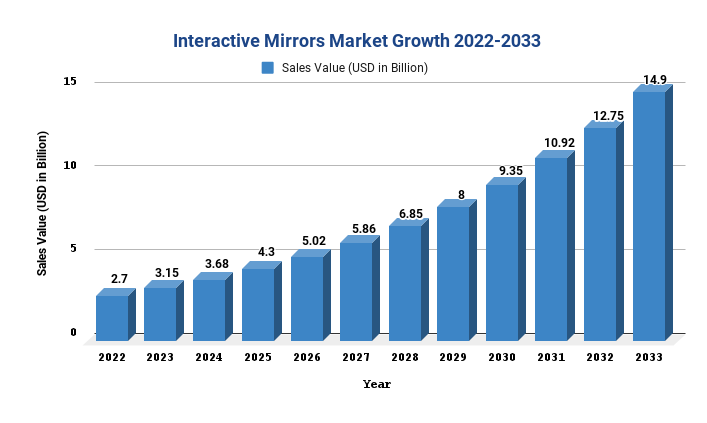Interactive Mirrors Market worth USD 14.90 Billion, growing at a 16.80% CAGR by 2033

Page Contents
Market Overview
Published Via 11Press: The Interactive Mirrors Market is anticipated to grow significantly in the coming years driven by factors such as the increasing adoption of smart homes and the growing demand for personalized shopping experiences. Some of the key applications of interactive mirrors include virtual try-on of clothing and makeup providing personalized skincare recommendations, and monitoring health parameters such as blood pressure and heart rate.
Interactive mirror technology is rapidly gaining popularity in the retail industry. This innovative technology is being used by retailers around the globe to show potential customers images of different products or items in 3D and 2D video mapping formats. This product can also be programmed to display a variety of products, allowing you to save on advertising costs and display media.
The Interactive Mirrors Market size is expected to grow at a compound annual growth rate (CAGR) of 16.80% from 2022 through 2033, rising from USD 2.7 billion in 2022 to reach USD 14.90 billion by 2033.
The touchscreen interactive surface makes it easier for customers to browse and make informed purchases. This improves customer experience. A major selling point is the enhanced 3D movie viewing experience with an interactive mirror. The market for interactive mirrors is still limited by the high costs involved in implementing them and privacy concerns among users.
The market share of global market revenues is currently dominated by Europe. North America follows closely. The major driver of revenue growth is the demand for smart mirrors in various sectors including automotive retail and consumer. Due to the small number of start-ups that have entered the market APAC's revenue is expected to see a significant increase over the next five year. Due to restrictions on fashion and dressing markets in Latin America and the Middle East and Africa are expected to experience low growth. However, GCC countries will see a strong demand for automobiles which will drive demand for smart mirrors during the forecast period.
 Key Takeaways
Key Takeaways
- Rising demand: The requirement for interactive mirrors is increasing rapidly due to their ability to enhance the customer experience in various industries such as retail, hospitality, healthcare and advertising.
- Advancements in technology: Technological advancements such as facial recognition, augmented reality and artificial intelligence have enabled interactive mirrors to offer personalized and interactive experiences to customers.
- Retail industry: Interactive mirrors have gained significant popularity in the retail industry as they allow customers to virtually try on clothing, makeup and accessories and also provide product information and recommendations.
- Hospitality industry: The hospitality industry is also acquiring interactive mirrors to enhance customer experiences in hotels, resorts and restaurants. Interactive mirrors can be used for entertainment, communication and even to order food and beverages.
- Healthcare industry: Interactive mirrors are being used in the healthcare industry for patient care and education as they can display medical information and provide interactive tools for patients to monitor their health.
- Advertising industry: Interactive mirrors are also being used in the advertising industry to display personalized ads and promotional content to customers based on their preferences and behavior.
- High cost: The cost of interactive mirrors is still relatively high, which may limit their adoption in some industries and for small businesses.
- Privacy concerns: With the use of facial recognition and other technologies, there are concerns about the privacy and security of personal information, which must be addressed to ensure the widespread adoption of interactive mirrors.
Request For Sample Report Here: https://marketresearch.biz/report/interactive-mirrors-market/request-sample/
Regional Snapshot
- The interactive mirrors market is a relatively new but rapidly growing market that offers a range of opportunities for companies operating in this space. The market for interactive mirrors is primarily driven by the growing demand for innovative and smart mirrors that can enhance the user experience and provide value-added services.
- In terms of regional markets, North America is currently the largest market for interactive mirrors accounting for the largest share of the market. This can be attributed to the high level of consumer awareness and disposable income in this region as well as the presence of several key players operating in this space.
- Europe is also a significant market for interactive mirrors, driven by the growing demand for smart homes and the increasing adoption of IoT-based technologies. The increasing focus on energy efficiency and sustainability in Europe has also led to the development of innovative interactive mirrors that can help reduce energy consumption and improve the overall user experience.
- The Asia Pacific region is also emerging as a key market for interactive mirrors with expanding demand for smart homes and connected devices navigating the growth of this market. The increasing penetration of smartphones and other mobile devices is also driving the demand for interactive mirrors that can be connected to these devices and offer a range of services.
- The interactive mirrors market is expected to continue to grow rapidly in the coming years, driven by technological advancements and increasing consumer demand for innovative and value-added products. While North America and Europe are currently the largest markets the Asia Pacific region is expected to emerge as a key growth driver in the coming years.
Ensure everything is in line with your specific requirements here: Ensure everything is in line with your specific requirements here: https://marketresearch.biz/report/interactive-mirrors-market/#inquiry
Drivers
- Increasing demand for smart homes: As more people adopt smart home technology, the demand for interactive mirrors is also increasing. Interactive mirrors can be integrated with smart home systems to provide personalized information and entertainment.
- Growing adoption of augmented reality: The use of augmented reality in interactive mirrors is becoming more common which is driving demand. Augmented reality allows for a more immersive and interactive experience, which is appealing to consumers.
- Rising trend of personalization: Consumers are increasingly seeking personalized products and services, and interactive mirrors can provide just that. These mirrors can be customized to display information and content that is relevant to the user's preferences and interests.
- Technological advancements: Advancements in technology, such as the development of more powerful processors and high-resolution displays are making interactive mirrors more practical and appealing.
- Growing awareness of health and wellness: Interactive mirrors can be used to provide health and wellness information such as fitness data and skincare recommendations. As more people become interested in maintaining their health and wellness the demand for these features will grow.
Restraints
- High cost: Interactive mirrors typically use advanced technology and components, which can make them expensive to produce and purchase. This could limit their adoption by some consumers and businesses.
- Limited market size: The market for interactive mirrors may be relatively small, as they are a niche product with specific applications. This could limit the potential for growth and expansion.
- Technical challenges: Interactive mirrors require advanced technology such as sensors, cameras, and software, to function properly. Developing and integrating these components can be complex and challenging.
- Privacy concerns: Interactive mirrors may raise privacy concerns as they can capture and store personal information, such as facial features and biometric data. This could limit their adoption in certain contexts such as public spaces.
- Competition from other technologies: Interactive mirrors may face competition from other emerging technologies, such as augmented reality and virtual reality. These technologies could offer similar or superior features and capabilities, which could limit the demand for interactive mirrors.
Opportunities
- Retail and fashion: Interactive mirrors can be a great addition to retail stores, allowing customers to virtually try on clothes, experiment with makeup or hairstyles, and receive personalized recommendations based on their preferences and previous purchases. These mirrors can enhance the overall shopping experience, increase engagement and ultimately drive sales.
- Hospitality: Interactive mirrors can be used in hotels, spas and other hospitality businesses to provide guests with a unique and immersive experience. For example, a mirror in a hotel room could display local recommendations, weather updates, and entertainment options. In a spa, a mirror could display information about treatments and products, as well as relaxing images and sounds.
- Home automation: Interactive mirrors can be integrated with smart home systems, allowing homeowners to control various devices and systems from a single interface. For example, a mirror could display the weather forecast, control the thermostat, play music and show live security camera footage.
- Healthcare: Interactive mirrors can be used in hospitals and other healthcare facilities to provide patients with real-time health information, such as heart rate, blood pressure and oxygen levels. This can help doctors and nurses monitor patients more effectively, and potentially reduce the need for invasive procedures.
- Advertising: Interactive mirrors can be used as an innovative advertising medium, allowing businesses to display ads in a more engaging and interactive way. For example, a mirror in a shopping mall could display an ad for a new product and allow customers to try it on virtually or a mirror in a gym could display an ad for a fitness product and allow customers to watch a video or receive workout recommendations.
Challenges
- High cost: One of the main challenges for the interactive mirror market is the high cost of the technology. The interactive mirrors are expensive to produce and the technology is still evolving, which makes it challenging for manufacturers to bring down the costs.
- Limited applications: Currently, interactive mirrors have limited applications which can make it difficult for manufacturers to scale up production. While they are popular in retail stores and fitting rooms there are limited other use cases that can justify the cost of the technology.
- Technical limitations: Interactive mirrors rely on sophisticated software and hardware to work correctly. This can create technical limitations that can affect the user experience such as lag time, slow response times and limited functionality.
- Privacy concerns: Interactive mirrors can collect data about users such as their preferences, purchasing habits, and personal information. This can create privacy concerns, especially in public spaces like retail stores and fitting rooms.
- Lack of consumer awareness: Despite the benefits of interactive mirrors, many consumers are still not aware of the technology. This can make it challenging for manufacturers to market and sell their products effectively.
- Integration with legacy systems: Often, interactive mirrors require integration with existing store systems such as inventory management and POS systems. This can be challenging for stores that have outdated legacy systems that are not compatible with interactive mirrors.
Market Segmentation:
Segmentation by component:
• Sensors
• Displays
• Cameras
• Others
Segmentation by end user:
• Automotive sector
• Healthcare sector
• Retail & advertising sector
• Consumer & residential sector
Key Players:
• Ad Notam AG
• Gentex Corp.
• Alkè
• Magna International Inc.
• Evervue
• Panasonic
• Pro Display
• Samsung Electronics Co. Ltd.
• Seura Tech2o
• Toshiba Corp
Report Scope
| Report Attribute | Details |
| Market size value in 2023 | USD 2.7 billion |
| Revenue forecast by 2033 | USD 14.90 billion |
| Growth Rate | CAGR of 16.80% |
| Regions Covered | North America, Europe, Asia Pacific, Latin America, and Middle East & Africa, and Rest of the World |
| Historical Years | 2017-2022 |
| Base Year | 2022 |
| Estimated Year | 2023 |
| Short-Term Projection Year | 2028 |
| Long-Term Projected Year | 2033 |
Recent Developments:
- Increased demand for augmented reality (AR) technology: AR technology is gaining popularity in the interactive mirror market as it provides an immersive experience to the users. Companies like Panasonic, Intel and Samsung are investing heavily in AR technology to develop interactive mirrors that offer a range of features such as virtual try-on, personalized styling, and interactive advertisements.
- Integration with AI technology: The integration of artificial intelligence (AI) technology is another recent development in the interactive mirror market. Interactive mirrors equipped with AI technology can analyze customer data, provide personalized recommendations and even predict future buying behavior. Several companies like Memomi and Vmirror have developed interactive mirrors that use AI technology to offer personalized styling recommendations to customers.
- Increasing demand for smart mirrors in the healthcare sector: The healthcare sector is another area where the interactive mirror market is seeing significant growth. Smart mirrors equipped with sensors and AI technology can help monitor a patient's vital signs, provide medication reminders and even track the progress of a patient's recovery. Companies like HSG and Iristrace have developed interactive mirrors specifically for the healthcare sector.
- Rise of virtual try-on technology: Virtual try-on technology is gaining popularity in the fashion and beauty industry. Interactive mirrors equipped with virtual try-on technology allow customers to try on different clothes, hairstyles and makeup virtually, without having to physically try them on. Companies like MemoMi and Holition have developed interactive mirrors with virtual try-on technology for fashion and beauty brands.
FAQ:
Q: What are the applications of interactive mirrors?
A: Interactive mirrors have a wide range of applications, including retail displays, smart home systems, healthcare, beauty and fashion, hospitality, and entertainment.
Q: What is the size of the Interactive Mirrors Market?
A: The Interactive Mirrors Market size is expected to grow by USD 14.90 billion by 2033 at a CAGR of 16.80%.
Q: What are some popular brands of interactive mirrors?
A: Magna International Inc, Evervue, Panasonic, Pro Display, Samsung Electronics Co. Ltd., Toshiba Corp.
Q: What is the future of the interactive mirror market?
A: The interactive mirror market is expected to continue growing in the coming years, driven by advancements in technology and increasing demand from various industries. The market is also expected to see increased adoption of augmented reality and virtual reality technology in interactive mirrors.
Q: What are some of the technologies used in interactive mirrors?
A: Interactive mirrors use a variety of technologies, including touchscreens, cameras, sensors, and augmented reality. They may also incorporate artificial intelligence and machine learning to provide personalized recommendations and improve the user experience.
Q: What are some factors to consider when choosing an interactive mirror?
A: When choosing an interactive mirror, it is important to consider factors such as the size and design of the mirror, the features it offers, the quality of the display, and the price. It is also important to consider the intended use of the mirror and the specific needs of the user or business.
Contact us
Contact Person: Mr. Lawrence John
Marketresearch.Biz (Powered By Prudour Pvt. Ltd.)
Tel: +1 (347) 796-4335
Send Email: [email protected]
Inquiry: [email protected]
The team behind market.us, marketresearch.biz, market.biz and more. Our purpose is to keep our customers ahead of the game with regard to the markets. They may fluctuate up or down, but we will help you to stay ahead of the curve in these market fluctuations. Our consistent growth and ability to deliver in-depth analyses and market insight has engaged genuine market players. They have faith in us to offer the data and information they require to make balanced and decisive marketing decisions.



